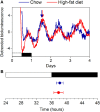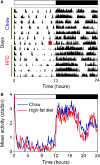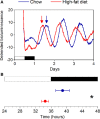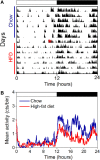High-Fat Feeding Does Not Disrupt Daily Rhythms in Female Mice because of Protection by Ovarian Hormones
- PMID: 28352249
- PMCID: PMC5348546
- DOI: 10.3389/fendo.2017.00044
High-Fat Feeding Does Not Disrupt Daily Rhythms in Female Mice because of Protection by Ovarian Hormones
Abstract
Obesity in women is increased by the loss of circulating estrogen after menopause. Shift work, which disrupts circadian rhythms, also increases the risk for obesity. It is not known whether ovarian hormones interact with the circadian system to protect females from obesity. During high-fat feeding, male C57BL/6J mice develop profound obesity and disruption of daily rhythms. Since C57BL/6J female mice did not develop diet-induced obesity (during 8 weeks of high-fat feeding), we first determined if daily rhythms in female mice were resistant to disruption from high-fat diet. We fed female PERIOD2:LUCIFERASE mice 45% high-fat diet for 1 week and measured daily rhythms. Female mice retained robust rhythms of eating behavior and locomotor activity during high-fat feeding that were similar to chow-fed females. In addition, the phase of the liver molecular timekeeping (PER2:LUC) rhythm was not altered by high-fat feeding in females. To determine if ovarian hormones protected daily rhythms in female mice from high-fat feeding, we analyzed rhythms in ovariectomized mice. During high-fat feeding, the amplitudes of the eating behavior and locomotor activity rhythms were reduced in ovariectomized females. Liver PER2:LUC rhythms were also advanced by ~4 h by high-fat feeding, but not chow, in ovariectomized females. Together these data show circulating ovarian hormones protect the integrity of daily rhythms in female mice during high-fat feeding.
Keywords: C57BL/6J; bioluminescence; circadian; eating rhythm; female; high-fat diet; liver; obesity.
Figures







Similar articles
-
Estradiol regulates daily rhythms underlying diet-induced obesity in female mice.Am J Physiol Endocrinol Metab. 2019 Dec 1;317(6):E1172-E1181. doi: 10.1152/ajpendo.00365.2019. Epub 2019 Nov 5. Am J Physiol Endocrinol Metab. 2019. PMID: 31689145 Free PMC article.
-
High-fat feeding disrupts daily eating behavior rhythms in obesity-prone but not in obesity-resistant male inbred mouse strains.Am J Physiol Regul Integr Comp Physiol. 2021 May 1;320(5):R619-R629. doi: 10.1152/ajpregu.00150.2020. Epub 2021 Feb 24. Am J Physiol Regul Integr Comp Physiol. 2021. PMID: 33626995 Free PMC article.
-
Wheel-running activity modulates circadian organization and the daily rhythm of eating behavior.Front Psychol. 2014 Mar 4;5:177. doi: 10.3389/fpsyg.2014.00177. eCollection 2014. Front Psychol. 2014. PMID: 24624109 Free PMC article.
-
Response of peripheral rhythms to the timing of food intake.Methods Enzymol. 2015;552:145-61. doi: 10.1016/bs.mie.2014.10.027. Epub 2014 Dec 27. Methods Enzymol. 2015. PMID: 25707276 Review.
-
Circadian Rhythms in Diet-Induced Obesity.Adv Exp Med Biol. 2017;960:19-52. doi: 10.1007/978-3-319-48382-5_2. Adv Exp Med Biol. 2017. PMID: 28585194 Review.
Cited by
-
Blue light at night acutely impairs glucose tolerance and increases sugar intake in the diurnal rodent Arvicanthis ansorgei in a sex-dependent manner.Physiol Rep. 2019 Oct;7(20):e14257. doi: 10.14814/phy2.14257. Physiol Rep. 2019. PMID: 31646762 Free PMC article.
-
Short-term high fat diet alters genes associated with metabolic and vascular dysfunction during adolescence in rats: a pilot study.PeerJ. 2021 Jul 9;9:e11714. doi: 10.7717/peerj.11714. eCollection 2021. PeerJ. 2021. PMID: 34285833 Free PMC article.
-
Hypothalamic REV-ERB nuclear receptors control diurnal food intake and leptin sensitivity in diet-induced obese mice.J Clin Invest. 2021 Jan 4;131(1):e140424. doi: 10.1172/JCI140424. J Clin Invest. 2021. PMID: 33021965 Free PMC article.
-
Night eating model shows time-specific depression-like behavior in the forced swimming test.Sci Rep. 2018 Jan 18;8(1):1081. doi: 10.1038/s41598-018-19433-8. Sci Rep. 2018. PMID: 29348553 Free PMC article.
-
Mice with humanized livers reveal the role of hepatocyte clocks in rhythmic behavior.Sci Adv. 2023 May 19;9(20):eadf2982. doi: 10.1126/sciadv.adf2982. Epub 2023 May 17. Sci Adv. 2023. PMID: 37196091 Free PMC article.
References
Grants and funding
LinkOut - more resources
Full Text Sources
Other Literature Sources

